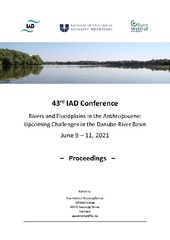Приказ основних података о документу
Occurrence and spread of human- induced antimicrobial resistance in a large river water system: developing a holistic picture based on the Joint Danube Survey 4 activities
| dc.contributor | Sandu, Cristina | |
| dc.contributor | Cyffka, Bernd | |
| dc.creator | Kirschner, Alexander K.T. | |
| dc.creator | Kittinger, Clemens | |
| dc.creator | Schachner, Iris | |
| dc.creator | Jakwerth, Stefan | |
| dc.creator | Koller, Michael | |
| dc.creator | Kolarević, Stoimir | |
| dc.creator | Kračun-Kolarević, Margareta | |
| dc.creator | Toumi, Marwene | |
| dc.creator | Farkas, Rosza | |
| dc.creator | Tóth, Erika | |
| dc.creator | Kandler, W | |
| dc.creator | Sulyok, M | |
| dc.creator | Savio, Domenico | |
| dc.creator | Farnleitner, Andreas H. | |
| dc.creator | Zarfel, Gernot | |
| dc.date.accessioned | 2022-01-19T14:00:33Z | |
| dc.date.available | 2022-01-19T14:00:33Z | |
| dc.date.issued | 2021 | |
| dc.identifier.uri | http://radar.ibiss.bg.ac.rs/handle/123456789/4731 | |
| dc.description.abstract | The problem of human-induced antimicrobial resistance (acquired due to human activities) is an emerging concern in aquatic environments. The isolation of (facultative) pathogenic organisms with acquired antibiotic resistance, even concerning last-line antibiotics, from rivers and lakes, is well documented throughout the world. In the last few years, there has been a rapid increase in the number of studies addressing these topics and their possible implications for human health. However, most studies concentrate on a relatively limited methodology, e.g. applying non-quantitative and either cultivation-based or direct-detection based molecular biological methods. In addition, often only small geographic areas and short periods of time are covered. This is one of the reasons why many relevant questions concerning the occurrence and spread of antimicrobial resistance in aquatic ecosystems still remain unanswered. The largest European river water survey (Joint Danube Survey 4) offered a unique opportunity to study the occurrence and spread of human-induced antimicrobial resistance along the whole Danube River. Within the research project, isolates from samples from the entire course of the Danube and their main tributaries, including high frequency sampling at selected locations, have been collected and analysed. Samples from the water compartment but also from submerged biofilms have been considered. State-of-the-art quantitative molecular biological techniques and culture-based analyses targeting different bacterial organisms have been combined with a large set of physical, chemical and biological parameters to obtain a robust and comprehensive picture of the occurrence and spread of human-induced antimicrobial resistance in the Danube River. Based on the findings of this quantitative, integrative study approach, it seems likely to significantly improve the current understanding on the importance on the spread and stabilization of human - induced antibiotic resistance in large rivers. The results of this study will also be useful to guide future monitoring and management strategies. | sr |
| dc.language.iso | en | sr |
| dc.publisher | Neuburg: Aueninstitut Neuburg | sr |
| dc.rights | openAccess | sr |
| dc.source | 43rd IAD Conference: Rivers and Floodplains in the Antropocene: Upcoming Challenges in the Danube River Basin | sr |
| dc.title | Occurrence and spread of human- induced antimicrobial resistance in a large river water system: developing a holistic picture based on the Joint Danube Survey 4 activities | sr |
| dc.type | conferenceObject | sr |
| dc.rights.license | ARR | sr |
| dc.rights.holder | © 2021 by the Aueninstitut Neuburg | sr |
| dc.description.other | Sandu C, Cyffka B, editors. Proceedings: 43rd IAD Conference: Rivers and Floodplains in the Anthropocene: Upcoming Challenges in the Danube River Basin; 2021 Jun 9-11; Neuburg, Germany. 2021. p. 20. | sr |
| dc.citation.spage | 20 | |
| dc.type.version | publishedVersion | sr |
| dc.identifier.fulltext | https://radar.ibiss.bg.ac.rs/bitstream/id/9746/43rd_IAD_Conference_Proceedings-20.pdf | |
| dc.citation.rank | M34 | |
| dc.identifier.rcub | https://hdl.handle.net/21.15107/rcub_ibiss_4731 |

